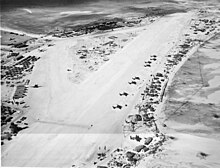Air raids of the Battle of the Gilbert Islands
| date | March 1 to November 20, 1943 |
|---|---|
| place | Tarawa , Gilbert Islands |
| output | American bombing. Only relatively minor damage to the Japanese defenses |
| Parties to the conflict | |
|---|---|
| Commander | |
|
High Command: |
|
| losses | |
|
315 aircraft. |
565 aircraft shot down or destroyed, several hundred soldiers killed or injured. Two or more bunkers blown up, four depots, one dock, three freighters. |
The Battle of Gilbert Islands air strikes were a series of bombings and attacks carried out by the USAAF in 1943 to weaken the defenses of Tarawa Atoll, in the Gilbert Islands . The US associations encountered heavy resistance and suffered heavy losses. In November 1943, US Marine Corps units landed on Tarawa and captured the island within four days in the Battle of the Gilbert Islands .
The 7th Air Force's main air strikes
12th of May
40 B-24 - bomber of the 7th Air Force attacked on May 12, the defenses of Betio , the largest island of the atoll of Tarawa. They came across a squadron of Japanese fighters led by Taniguchi Hu . The Japanese squadron sparked the formation and attacked. Two B-24 bombers were shot down immediately, six more were damaged. Presumably they later had to make an emergency landing on Tarawa. The remaining bombers continued to fly and their machine guns shot down a Mitsubishi A6M Zero. The US formation flew over Betio at 12:00 p.m. and bombed several ammunition depots . A bomb hit the airfield and destroyed an airplane. On the way back, the bombers were attacked again by Japanese planes. Another B-24 crashed. All the others arrived intact at Funafuti airfield in the Ellice Islands .
23rd June
30 B-25 bombers, escorted by 25 F6F "Hellcat" aircraft, flew over Betio in the afternoon. They dropped about 600 bombs over the airfield. 67 Japanese planes were shot down or devastated. Three bombers and six F6Fs were lost. The island's anti-aircraft defense fired at the American squadrons, damaging around ten B-25s.
25th June
Sixty bombers, B-25 and B-24, with an escort of 30 F6F attacked Betio again. The Japanese were ready and received the formation with heavy flak fire. Several dozen fighter planes were already in the air. An aerial battle broke out between the Japanese and American fighters. 54 Japanese were shot down, as well as 12 Americans. A bomber was hit by the flak and had to make an emergency landing . Another US bomber fell into the sea about 100 miles from the Funafuti airfield due to a lack of fuel . Everyone else unloaded the bombs over the airfield and over the small harbor. A Japanese transport ship , the Saida Maru , was hit and sunk. A minesweeper was also hit, but not sunk.
17th of September
25 7th Air Force bombers bombed Betio before dawn, destroying 16 of the remaining 45 aircraft on the ground. Then 90 F6F, F4U Corsair and SBD Dauntless of the aircraft carriers USS Lexington , USS Princeton and USS Belleau Wood flew over Betio by Admiral Pownall. They attacked the fortifications at low altitude and fired at the flak cannons on the ground. The remaining 29 Zeros intervened, but were all shot down. 17 Americans were also hit. Some bombers had meanwhile flown over Betio with incendiary bombs and had bombed the airfield again. The Japanese flak scored 6 hits that day.
September 18
The aerial battle of September 18 was the most violent of the bombardments over Tarawa. About 100 Japanese fighters were flying over Betio when a formation of US bombers, escorted by 50 F6Fs, appeared. The aerial battle ended with the victory of the Americans. Lieutenant Hu's Mitsubishi A6M was shot down. He was probably dead before the crash.
September 19th
67 aircraft carrier fighters attacked at dawn, surprising about 60 Japanese aircraft that were about to land on Betio. 56 aircraft were shot down in the air and another 3 devastated, while American losses were only 11 aircraft. The anti-aircraft gun was not used, and the fighter pilots damaged some hangars, a petrol depot and two bunkers while flying low.
September 20th
120 fighters attacked Betio and about 40 bombers arrived in the afternoon. Two flying boats torpedoed a small freighter without sinking it. Another 25 Japanese planes were shot down and 11 devastated. American losses were also high: 13 fighters and 23 bombers shot down. Admiral Shibazaki Keiji , commander of the Tarawa garrison , decided to send his remaining six planes to Truk to avoid further casualties.
21st November
Operation Galvanic , the cover name of the entire company for the capture of the Gilbert Islands, started on November 20, 1943. 140 fighters and 60 bombers attacked Betio in the morning. The invasion fleet, around 100 ships, shot at Tarawa at all barriers. The air raids had only slightly weakened Betio. When the Americans landed, the island was defenseless. However, the Japanese defenders had orders to hold the tarmac . On the first day of the battle the first line of fortification held, on the second it was breached and the marines took the airfield. The battle lost 1,200 US deaths and 4,800 Japanese.
literature
- Bernard Millot: The Pacific War . BUR, Montreuil 1967.
- Paul S. Dull: A Battle History of the Imperial Japanese Navy . Naval Inst. Press, Annapolis 2002.
- Robert L. Shaw: Fighter Combat - tactics and maneuvering. Naval Inst. Press, Annapolis 2005, ISBN 0-87021-059-9 .



